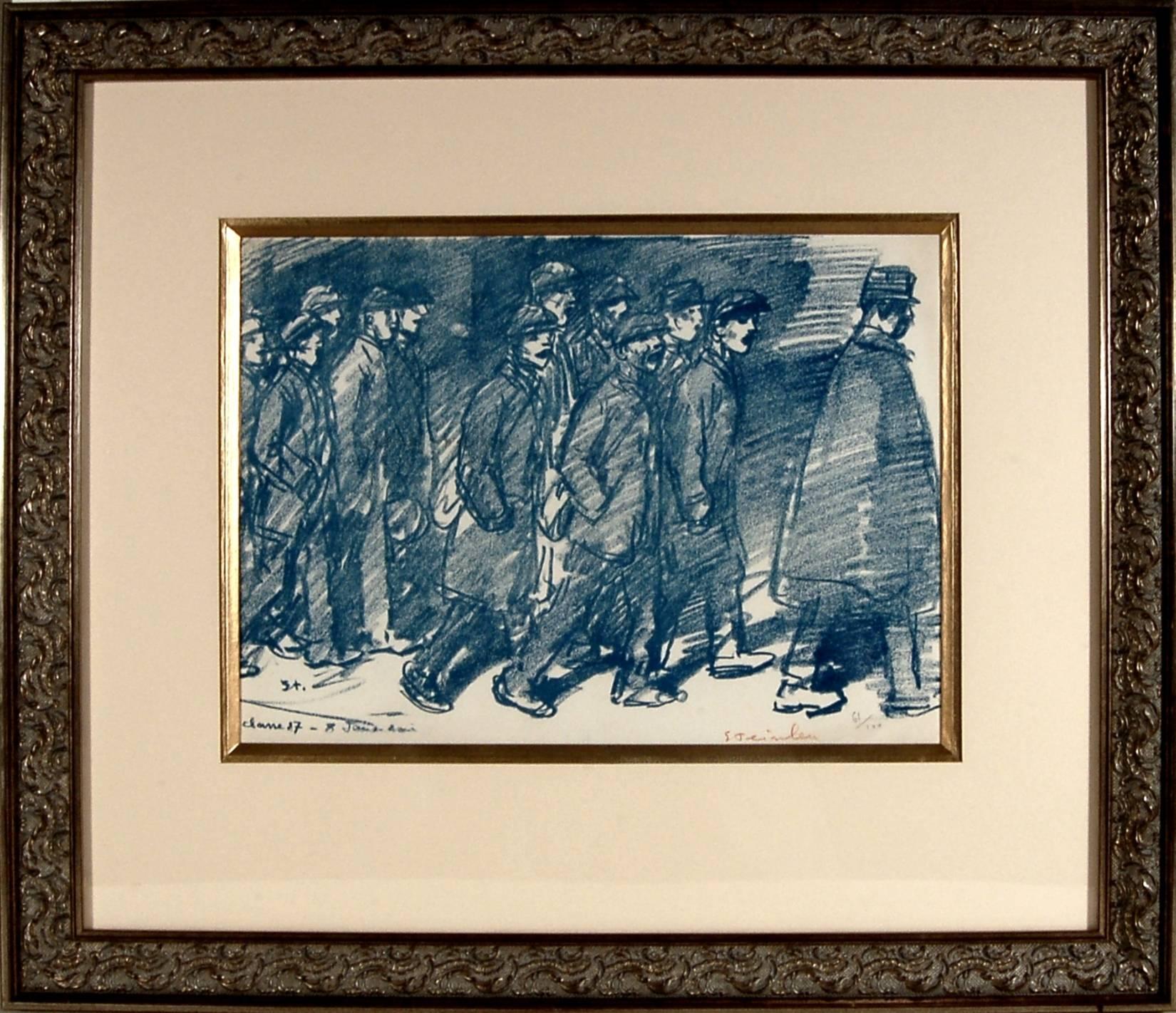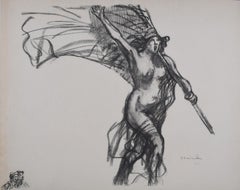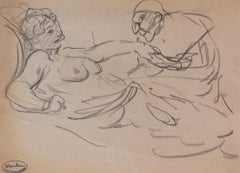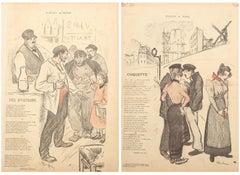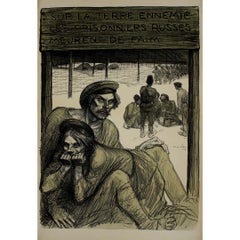Want more images or videos?
Request additional images or videos from the seller
1 of 8
Théophile Alexandre SteinlenUntitledc.1915
c.1915
$750
£581.99
€657.11
CA$1,073.18
A$1,171.04
CHF 605.86
MX$14,009.10
NOK 7,653.42
SEK 7,186.44
DKK 4,907.44
About the Item
Artist: Theophile Alexandre Steinlen (Swiss, 1859-1923)
Title: Untitled
Year: c.1915
Medium: Lithograph
Edition: Unknown, probably 400
Paper: Thin vellum
Image size: 10 x 17 inches
Sheet size: 14.75 x 22 inches
Signature: Hand signed in pencil by the artist, also signed in the stone.
Printer: Verneau, Paris
Condition: Very good
About the artist:
Born in Lausanne, Switzerland on November 10, 1859, he moved permanently to Paris at age 23 and became a French citizen. Steinlen studied art at Lausanne and later became active as a textile designer in Mulhause. In 1882 he arrived in Paris where he worked as an illustrator for the journals Mirliton, Assiette au Beurre, Chat Noir, and Gil Blas, for which he produced over four hundred lithographs. In the early 1890s, Steinlen's paintings of rural landscapes, flowers, and nudes were being shown at the Salon des Indépendants.
Besides illustrating advertisements for a variety of products, Steinlen was famous for his posters of cabaret and music hall performers . His later work for the journals, like that of Toulouse Lautrec, became increasingly satirical and critical of society. His permanent home, Montmartre and its environs was a favorite subject throughout Steinlen's life and he often painted genre scenes of the working class, capturing day-to-day life in Paris with a simple, endearing style. Between 1914 and 1918 he produced many lithographs depicting the first world war, especially the suffering of the civil population under the Germans occupation. A large collection of his lithographs and etchings are held at the Louvre museum in Paris.
Steinlen's works can be found at many important museums around the world including at the Hermitage Museum in St. Petersburg, Russia and the National Gallery of Art in Washington, D.C., United States.
Théophile Steinlen died in 1923 in Paris and was laid to rest in the Cimetière Saint-Vincent in Montmartre.
- Creator:Théophile Alexandre Steinlen (1859 - 1923, French)
- Creation Year:c.1915
- Dimensions:Height: 14.75 in (37.47 cm)Width: 22 in (55.88 cm)Depth: 0.01 in (0.26 mm)
- Medium:
- Movement & Style:
- Period:
- Condition:
- Gallery Location:San Francisco, CA
- Reference Number:Seller: ste/unt/011stDibs: LU66635760381
Théophile Alexandre Steinlen
Theophile Alexandre Steinlen was born in Lausanne in 1859. He was naturalized French in 1901. He was a painter, engraver, illustrator, poster artist and sculptor. Before settling in Paris, he made a detour to Mulhouse where one of his uncles placed him in the studio of one of the best lithographers of the time. He settled definitively in Montmartre in 1881. Willette introduced him to his companions of the Cabaret du Chat-Noir animated by Rodolphe Salis. He met Toulouse-Lautrec, Forain, Léandre, Debussy, Eric Satie, Verlaine, Alphonse Allais and Aristide Bruant. He took part in the performances of the famous cabaret's shadow theater with animal stories and, most often, sequences featuring cats, for which he has a particular affection. The felines will appear throughout his activity as "parentheses" in a tormented work. There is, in this torment, the expression of no personal problem but a painful compassion for the lives of the exploited and marginal beings. He painted and drew idylls, balls and bastrings, workers, kids and gosselin, the poor, the little workers, girls and marlous. He sometimes made posters. In the most successful of them (« Le lait pur de la Vingeanne » et le « Fer Bravais ») he imposed, relevant or not, the presence of cats.
In 1901, Steinlen worked for L'Assiette au beurre , the most virulent satirical newspaper ever published and takes readily to target the institutions of the 3rd Republic.
His works are found in numerous Public Collections, such as Petit Palais in Geneva, Hermitage Museum in Saint Petersburg, and the National Gallery of Art in Washington.
About the Seller
5.0
Platinum Seller
Premium sellers with a 4.7+ rating and 24-hour response times
Established in 1999
1stDibs seller since 2017
856 sales on 1stDibs
Typical response time: 1 hour
- ShippingRetrieving quote...Shipping from: San Francisco, CA
- Return Policy
More From This Seller
View AllRetour de Guerre
By Théophile Alexandre Steinlen
Located in San Francisco, CA
Artist: Theophile Alexandre Steinlen (Swiss, 1859-1923)
Title: Retour de Guerre
Year: 1915
Medium: Lithograph
Edition: Numbered 97/100 in pencil
Paper: Wove
Image size: 11.5 ...
Category
Early 20th Century Realist Figurative Prints
Materials
Lithograph
Gares
By Théophile Alexandre Steinlen
Located in San Francisco, CA
Artist: Theophile Alexandre Steinlen (Swiss, 1859-1923)
Title: Gares
Year: 1916
Medium: Lithograph
Edition: Unknown, probably 400
Paper: Japan
Image size: 11 x 8.5 inches
She...
Category
Early 20th Century Realist Figurative Prints
Materials
Lithograph
Evacues
By Théophile Alexandre Steinlen
Located in San Francisco, CA
Artist: Theophile Alexandre Steinlen (Swiss, 1859-1923)
Title: Evacues
Year: 1916
Medium: Lithograph
Edition: Numbered 98/100 in pencil
Paper: Japan
Image size: 14 x 9.5 inch...
Category
Early 20th Century Realist Figurative Prints
Materials
Lithograph
A Bientot Pour de Bon
By Théophile Alexandre Steinlen
Located in San Francisco, CA
Artist: Theophile Alexandre Steinlen (Swiss, 1859-1923)
Title: A Bientot Pour de Bon
Year: 1916
Medium: Lithograph
Edition: Numbered 99/100 in pencil
Pa...
Category
Early 20th Century Realist Figurative Prints
Materials
Lithograph
Les Voila
By Théophile Alexandre Steinlen
Located in San Francisco, CA
Artist: Theophile Alexandre Steinlen (Swiss, 1859-1923)
Title: Les Voila
Year: 1915
Medium: Original lithograph
Edition: Numbered 73/100 in pencil
Paper: Wove
Size image: 16 ...
Category
Early 19th Century Academic Figurative Prints
Materials
Lithograph
Classe 17
By Théophile Alexandre Steinlen
Located in San Francisco, CA
Artist: Theophile Alexandre Steinlen (Swiss, 1859-1923)
Title: Classe 17
Year: 1917
Medium: Lithograph
Edition: Numbered 61/100 in pencil
Paper: Wove
Image size: 10.5 x 14.25 inches
...
Category
Early 19th Century Realist Figurative Prints
Materials
Lithograph
You May Also Like
“La Rèpublique nous appelle…” (The Republic calls us…)
By Théophile Alexandre Steinlen
Located in Fairlawn, OH
La République Nous Appelle (The Republic Calls Us)
Transfer lithograph with an etching Remarque in the lower left corner, 1915
Signed in pencil lower right (see photo)
Edition: 100 (...
Category
1910s Figurative Prints
Materials
Lithograph
The Forgiveness
By Théophile Alexandre Steinlen
Located in London, GB
THEOPHILE ALEXANDRE STEINLEN 1859-1923
Lausanne 1859-1923 Paris (Swiss/French)
Title: The Forgiveness, ca. 1901
Technique: Original Stamped Pencil Drawing on paper.
size: 21 x 2...
Category
Early 1900s Contemporary Drawings and Watercolor Paintings
Materials
Pencil
Gil Blas Illustrated, Art Nouveau Lithograph by Theophile Alexandre Steinlen
By Théophile Alexandre Steinlen
Located in Long Island City, NY
Theophile Alexandre Steinlen, French/Swiss (1859 - 1923) - Gil Blas Illustrated, Medium: Double Sided Lithograph, Size: 15 x 10.25 in. (38.1 x 26.04 cm), Description: From the colle...
Category
Early 20th Century Art Nouveau Figurative Prints
Materials
Lithograph
Original 1917 lithographic poster by Steinlen - World War I
By Théophile Alexandre Steinlen
Located in PARIS, FR
This haunting original 1917 lithographic poster by the renowned Swiss-French artist Théophile Steinlen was created during the final years of World War I. The stark title, "Sur la ter...
Category
1910s Prints and Multiples
Materials
Paper, Lithograph
Femme de Chagrin
By Théophile Alexandre Steinlen
Located in New York, NY
Theophile Alexandre Steinlen (1859-1923), Femme de Chagrin, 1894, lithograph, signed in pencil lower right [also signed in the plate lower center]. Reference: Crauzat 454, first stat...
Category
1890s Post-Impressionist Figurative Prints
Materials
Color Pencil, Lithograph
"La grande sœur" original drypoint
By Théophile Alexandre Steinlen
Located in Henderson, NV
Medium: original etching and drypoint. Catalogue reference: Sanchez and Seydoux 1913-10. Printed in 1913 and published in Paris by Gazette des Beaux-Arts. Sheet size: 8 1/2 x 6 inche...
Category
1910s Portrait Prints
Materials
Etching
More Ways To Browse
Antique St Petersburg Russia
Marc Chagall Art Books
Marc Chagall Bible Series
Marc Chagall Granada
Marc Chagall Green River
Marc Chagall Odyssey
Marc Chagall Towards Another Light
Marcus Brutus
Mardi Gras Posters Vintage
Margaret Keane Lithograph
Maria Farmer
Maria Laredo
Marie Fox
Marine Flag
Max Coyer
Medusa Dali
Michael Godard
Mickey Mouse Lithograph
